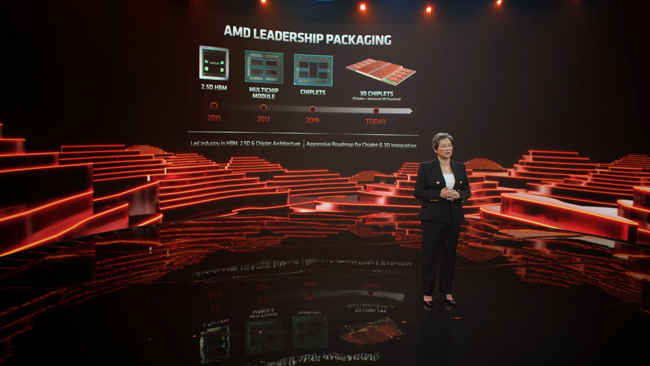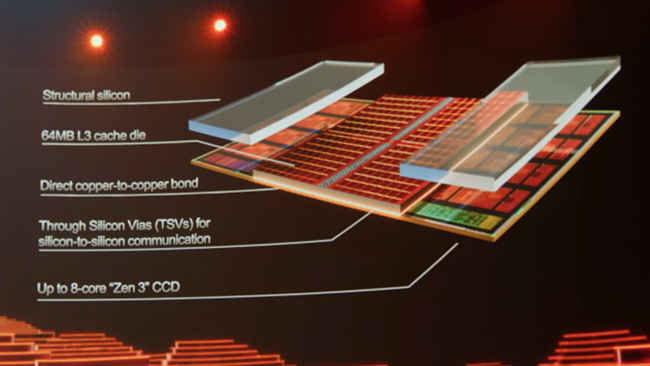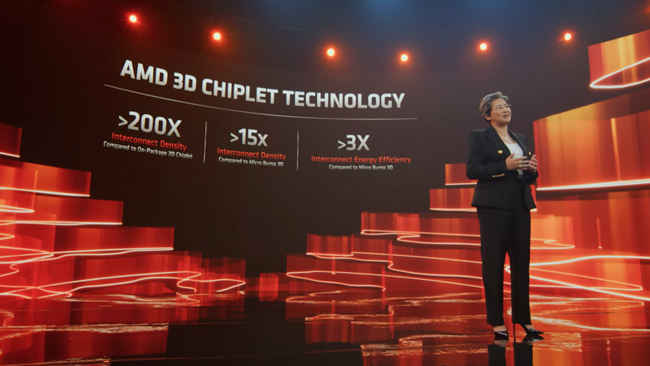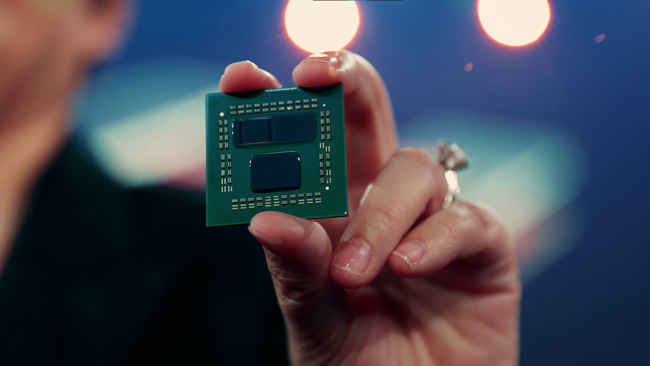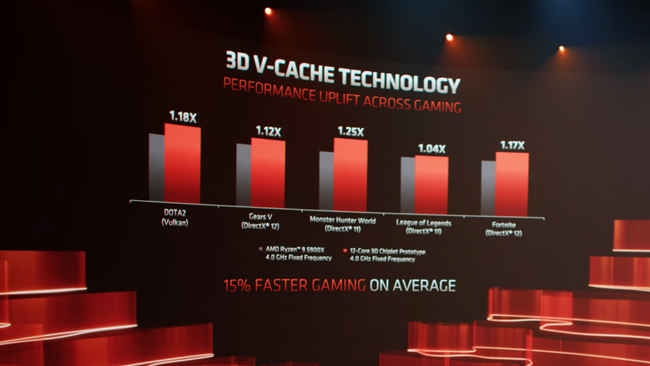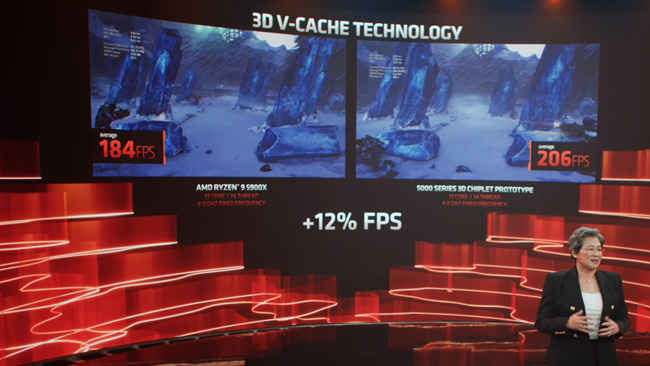COMPUTEX 2021 – AMD unveils 3D V-Cache technology bringing L3 Cache on Ryzen CPUs to 192 MB, 15% gaming performance improvement
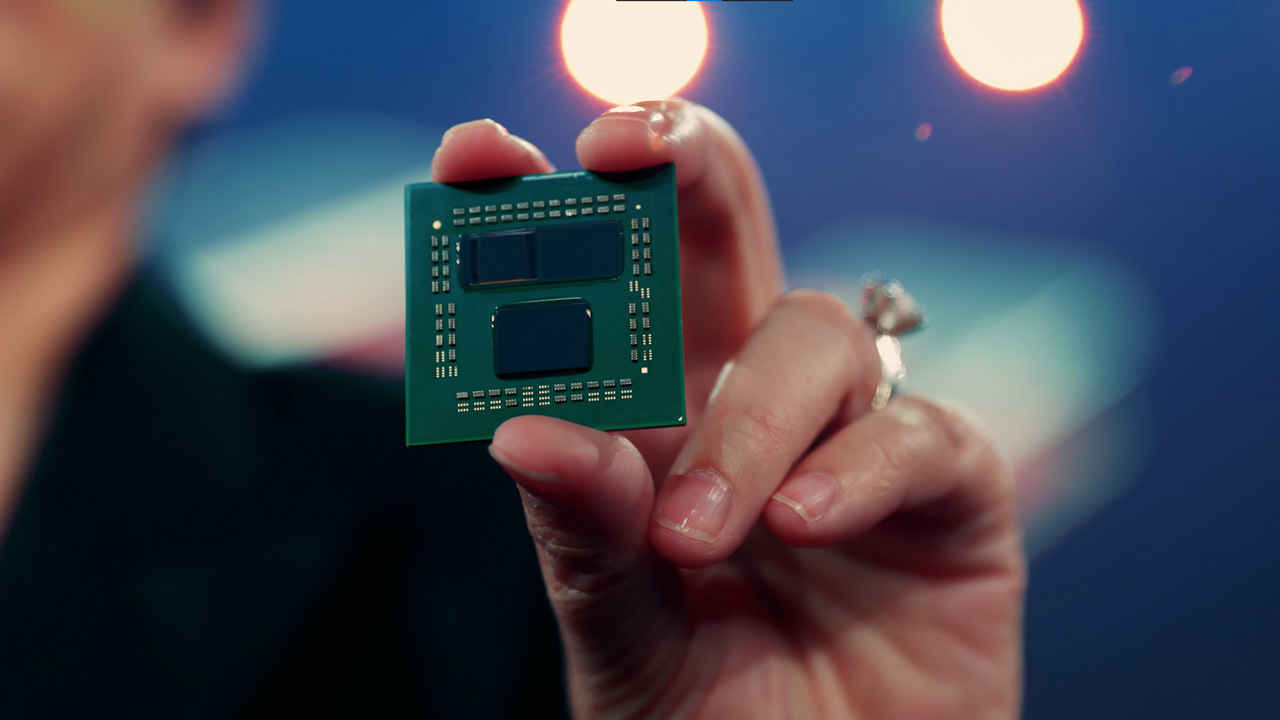
AMD introduced 3D packaging technology for consumer and enterprise processors during the COMPUTEX 2021 keynote
Ryzen processors with 3D V-Cache will see up to 192 MB of L3 Cache and a bandwidth of 2 TB/s
Prototype Ryzen 9 5900X with 3D V-Cache demonstrated 15% average gaming performance improvement
AMD’s COMPUTEX 2021 keynote saw many key product announcements including upcoming Ryzen 5000 series APUs, mobile Radeon RX 6000M GPUs, collaboration with Samsung for their Exynos mobile processors which will incorporate Radeon RDNA2 GPUs and lastly, FidelityFX Super Resolution (FSR) which is AMD’s answer to NVIDIA’s DLSS feature. While each of these were notable announcements, the most surprising announcement – 3D V-Cache – was left for last and it’s all about boosting the L3 Cache of AMD Ryzen processors.
3D V-Cache is an implementation of the 3D packaging technology by TSMC called 3DFabric which was announced back in August 2020. 3D packaging technologies allow silicon manufacturers to stack multiple silicon chips on top of each other and save space on the substrate. You could stack any sort of chiplets onto another, so you could add more processor dies if heating isn’t going to be an issue or stack memory on top of processor dies. It also helps to ensure that existing components within the PC ecosystem don’t need to be massively overhauled to ensure compatibility with processors. AMD or TSMC isn’t the only one with 3D Stacking technology. Intel had already unveiled Foveros in 2019 and we’ve also seen its implementation in Lakefield processors built for thin-and-light form factors.
AMD 3D V-Cache – Boosting L3 Cache to 192 MB
AMD is using 3D V-Cache to stack SRAM onto the CCDs in their Ryzen processors as well as for their HPC products. This allows AMD to increase the L3 Cache of their processors by a ridiculous amount. Existing AMD Zen 3 processor CCDs can have a maximum of 32 MB of L3 Cache that’s equally available to all cores within the CCD. With 3D V-Cache, AMD can stack an additional 64 MB of SRAM on top of each CCD to take the L3 Cache of each CCD to 96 MB. Which means, each high-end AMD Ryzen desktop processor such as the Ryzen 9 5950X or 5900X can have up to 192 MB of L3 Cache in total. This does not mean that entry-level and mid-range CPUs will not have 3D V-Cache. We’re bound to see a lot more SKUs from AMD in the coming months. AMD CEO also said that this is the “first” implementation of 3D packaging technology leaving room for more surprises in the coming years.
The SRAM cache is being bonded to the CCD directly using TSVs (Through Silicon Vias) and the data rate for these interconnects would be up to 2 TB/s. Since the stacked SRAM adds to the height of the CCD, additional structural silicon is added on to either side to increase the height of the entire CCD and make it uniform. At the end, a CCD with additional SRAM stacked onto it using 3D V-Cache will look the same from above. Moreover, the structural silicon would ensure proper heat dissipation since it will be connected to the IHS (Integrated Heat Sink).
AMD also stated that this particular packaging technology allows for more than 200x interconnect density when compared to 2D packaging technologies, more than 15x density compared to 3D microbump technology (which is akin to how Intel’s Foveros is implemented) and more than 3x interconnect efficiency compared to microbump technology. Intel’s upcoming 12th Gen Core processors codenamed ‘Alder Lake’ are rumoured to employ Foveros stacking technology. So AMD and Intel could both release desktop processors with 3D Stacking technology later this year.
The same 3D V-Cache technology when implemented on AMD’s EPYC server processors such as the EPYC 7763 could see up to 768 MB of L3 Cache. This makes a lot more sense in HPC applications since servers tend to deal with a lot of high-bandwidth big-data applications which can benefit from a much larger L3 Cache.
15% more gaming performance with 3D V-Cache
AMD showcased a prototype which was built on the AMD Zen 3 based Ryzen 9 5900X (12-Cores / 24-Threads) with an L3 Cache of 192 MB thanks to 3D V-Cache. When put through a few gaming workloads, the prototype Ryzen 9 5900X managed to get an average performance improvement of 15 per cent over a normal Ryzen 9 5900X.
In Gears 5, the two processors were locked at 4.0 GHz and the vanilla 5900X scored 184 FPS whereas the 3D V-Cache enabled prototype scored 206 FPS which works out to 12%. AMD also shared a few additional graphs showing FPS increases in games such as DOTA 2 (18%), Monster Hunter World (25%), League of Legends (4%) and Fortnite (17%).
3D V-Cache enters mass production this year
At the COMPUTEX 2021 keynote, AMD CEO also announced that volume production of AMD products incorporating 3D V-Cache technology would begin in August 2021.
Mithun Mohandas
Mithun Mohandas is an Indian technology journalist with 10 years of experience covering consumer technology. He is currently employed at Digit in the capacity of a Managing Editor. Mithun has a background in Computer Engineering and was an active member of the IEEE during his college days. He has a penchant for digging deep into unravelling what makes a device tick. If there's a transistor in it, Mithun's probably going to rip it apart till he finds it. At Digit, he covers processors, graphics cards, storage media, displays and networking devices aside from anything developer related. As an avid PC gamer, he prefers RTS and FPS titles, and can be quite competitive in a race to the finish line. He only gets consoles for the exclusives. He can be seen playing Valorant, World of Tanks, HITMAN and the occasional Age of Empires or being the voice behind hundreds of Digit videos. View Full Profile

